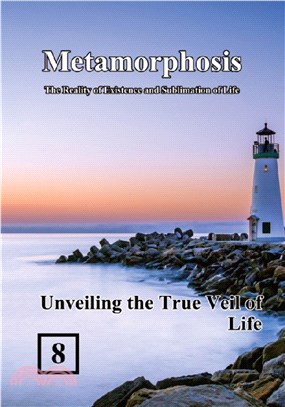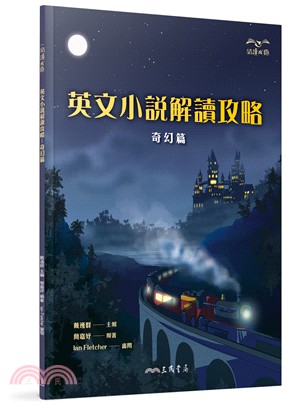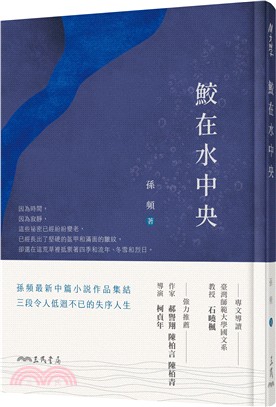蛻變:生命存在與昇華的實相(國際英文版:卷八)
商品資訊
ISBN13:9781647841867
出版社:漢世紀數位文化EHGBooks
作者:張善通
出版日:2023/02/01
裝訂/頁數:平裝/966頁
規格:22.8cm*15.2cm (高/寬)
定價
:NT$ 2700 元優惠價
:79 折 2133 元
無庫存,下單後進貨(採購期約4~10個工作天)
下單可得紅利積點:63 點
商品簡介
作者簡介
目次
相關商品
商品簡介
Nowadays, you and I are in the midst of AI, big data, multimedia, gossip, rumors, materialistic desires, and the great trend of the times.In the midst of the confusion and material satisfaction caused by complicated and novel things, have you ever thought about examining life with a reflective attitude and taking a careful and quiet look at life, the apparent convenience and innovation of technological civilization, but deepening the hidden nature of life that is hard to erase and sad and miserable at the bottom of our habitual thinking?
If human life is like a special, unusual, significant and far-reaching key, every morning when you wake up to take it, you have to fill out the application form carefully and seriously, without being meticulous.
Before going to sleep at night, thank God for today's gift and return the key to life with gratitude.
If we have used the key of life thousands of times, over and over again, then why do we have to do as Sisyphus did, with great effort, to push a boulder up a mountain?
After pushing a boulder up to the top of the mountain, we let it roll back down again, and so on, day after day, applying and repeating forever. ......
Imagine when we return the key to life, do we take an introspective attitude and examine our life deeply: what have we achieved today? What have we failed?
So one cannot help but ask: which direction should we choose for the existence of the universe and life itself, and what lifestyle should we adopt?
What is the value of the existence of life itself, and what is the true meaning of the existence of life itself?
What if the days of our existence in the universe, in life itself, always begin under such hard-won circumstances?
If our cosmic life existence, our existence itself, has always started in such a hard way and ended in such a sad way, then we must have a deeper self-awareness and reflection on our cosmic life existence, our existence itself.
Therefore, the question of life and death will again become a sharp and sensitive issue.
The Eastern and Western philosophies of life have, for ages, attempted to unravel the mystery of life and death in the existence of everything in the universe itself, in order to understand the true meaning of the existence of the world around us.
They attribute life to the simple "existence" that distinguishes between animals and inanimate things, and to the "mind" that is uniquely human.
It even goes on to use the phenomena that differentiate everything from one generation to another and the various theories that explain these phenomena, in order to decipher the existence of life in the universe.
To decipher the knowledge and culture inherent in the existence of life in the universe. It serves the purpose of the existence and evolution of a certain kind of being itself.
However, "mind" is a sum of the ability to realize the motive by the biological reaction of people through the precipitation and storage of known things.
It is the sum of all the thinking abilities to feel, observe, understand, judge, choose, remember, imagine, hypothesize, and reason, and then to guide their behavior according to it.
Thus, 'mind' covers the 'philosophical' level: the accumulation and storage of the known (subconscious); combined with the 'biological' (consciousness) level of brain information processing, that is, 'physiological response'.
The "mental" activity that engages in the conscious effort to achieve a certain ideal or purpose, thus consciously defining the purpose, is applied to the mental state.
However, the "mind" that can understand its own mental state and that of the human beings around it occurs mostly in the subconscious, and human beings can only receive the perceptible form of the combined manifestation of external feelings through the "senses.
The imagination compares and categorizes the perceptible forms, and the similar perceptible forms are grouped into one impression, and the perceptible forms begin to appear.
This assertion is in fact a statement of a very important fact, that although man has the ability to be autonomous, to master himself and to realize his own existence, he is the only one who is able to do so by reason.
In other words, man is the only being who exists in the way of rational "being", but the human brain does not automatically produce consciousness.
Consciousness is formed only when objective things are reflected to the human brain and processed by the human brain.
In other words, the attempt to uncover the true meaning of the existence of the universe and life itself is a constant and unchanging opportunity to establish the inner reality of the self.
If one does not seek deeper into one's own consciousness to establish an inner reality that one can grasp and that is hidden in one's heart.
Then, the inquiry into the existence of life in the universe, the true meaning of existence itself, will only be transformed into the pursuit toward the existence of things outside of the body, but not in the establishment of the inner value of the human self.
Therefore, the existence of life itself can only be grasped by consciousness through inner experience and intuitive methods.
The external factor can only work by revealing the substance of what is hidden inside things to all objects or phenomena that exist objectively in nature.
Reason can only grasp what is static enough to understand natural phenomena, but it cannot grasp the universe, human nature, or human spiritual culture.
Therefore, it is necessary to give prominence to will, emotion, and intuition in the field of philosophy of life and psychiatry in order to avoid the negation of humanity, personality, and freedom of will.
And in Leibovich's post-Nietzschean philosophy, it is from the radical aesthetics of the Stefan Georges school to the "life" phenomenon of existence itself as a whole, the existence of the universe life life itself.
The existence of life itself is always the core of the philosophy of life, and the existence of life itself is always the core problem of all cosmic life and life itself.
To sum up, if we can examine life deeply with a reflective attitude, and see things with wisdom, and look at the universe and the world quietly.
We will easily find that the inquiry of natural science in Western culture can be explained by the universal law of cause and effect; the study of psychiatry is the understanding and experience of the meaning of the existence of life.
Arthur Schopenhauer (1788~1860) and Friedrich Nietzsche (1844~1900) opposed the suppression and alienation of human emotions by rationalism and mechanism, and affirmed the importance of the "will to live" (Wille zum Leben).
Since human consciousness is not under the impact of rational control and flows freely like water, existentialist philosophers of life, such as Socrates, Plato, ...... Kierkegaard, Schopenhauer, Hegel, Nietzsche, Heidegger ......, etc.
What is the interpretation of the existence of life, the stream of consciousness of human meaning, the will to live as the essence of life, and the strong will as the origin of existence, or the highest value standard?
The Oriental "Phenomenology of Consciousness" explores the phenomenon of "using psychological knowledge to record the experience of the development of human psychological consciousness without limitation, or only subconsciously.
What kind of interpretation can the Eastern cultural philosophy of life offer to the question of the true meaning of the existence of life in the universe? "Consciousness" is a "fleeting phenomenon of life" in space and time.
How is it that "the phenomenon of existence is the essence of life", as Husserl says, and how is it that "consciousness" is a "phenomenon of life", as Jean-Paul Sartre says in "Being and Nothingness"? How to translate "Being and Nothingness" by Jean-Paul Sartre or "Being and Time" by Heidegger into "Tao" as the origin of the universe by Laozi (Li Er) from the East?
It is also a test of "this is, therefore, the other is, this is born, therefore, the other is born, this is not, therefore, the other is not, this is not, therefore, the other is not", and the possibility of cultural exchange, dialogue and integration between East and West is sought.
Therefore, in the book "Metamorphosis", we take the perspective of "consciousness" to know the "movement" of the body by chanting the head meditation "movement" and the "cessation" of the body by chanting the head meditation "cessation" to understand the true experience of birth, dwelling, change, and death of the body and mind.
Seeking the truth that is objectively discernible and exists independently of itself." The truth of "actual existence and non-nothingness" is the clarification of "the true appearance of the existence and metamorphosis and ascension of life.
It is the translation of "the true face of the existence and metamorphic ascension of life. Eight themes are presented through four stages of "confusion and search - perception and interpretation - awakening and breakthrough - metamorphosis and sublimation". The Unsolved Mystery of Life; The Awakening of Existentialism in East and West; Jasper + Kierkegaard + Martin Buber's Philosophy of Life; Heidegger's Temporal Transformation; Schart's Existence and Hegel's Negation of Negation; The Metamorphosis and Sublimation of Transcendental Life; and The Reality of Truth Unveiled.
However, no real answers will be given during this book's inquiry into the reality of truth, but you will be guided to straightforward ideas that will emerge quickly without much thought process. It will help you look at your life and analyze your problems.
From your own perception beyond all objects or phenomena in nature and the external material world, the process of self-awakening and contradiction will help you discover the problems in your life. The discovery of problems from self-awakening will eventually lead to the true unveiling of the mystery of the existence of life itself.
If human life is like a special, unusual, significant and far-reaching key, every morning when you wake up to take it, you have to fill out the application form carefully and seriously, without being meticulous.
Before going to sleep at night, thank God for today's gift and return the key to life with gratitude.
If we have used the key of life thousands of times, over and over again, then why do we have to do as Sisyphus did, with great effort, to push a boulder up a mountain?
After pushing a boulder up to the top of the mountain, we let it roll back down again, and so on, day after day, applying and repeating forever. ......
Imagine when we return the key to life, do we take an introspective attitude and examine our life deeply: what have we achieved today? What have we failed?
So one cannot help but ask: which direction should we choose for the existence of the universe and life itself, and what lifestyle should we adopt?
What is the value of the existence of life itself, and what is the true meaning of the existence of life itself?
What if the days of our existence in the universe, in life itself, always begin under such hard-won circumstances?
If our cosmic life existence, our existence itself, has always started in such a hard way and ended in such a sad way, then we must have a deeper self-awareness and reflection on our cosmic life existence, our existence itself.
Therefore, the question of life and death will again become a sharp and sensitive issue.
The Eastern and Western philosophies of life have, for ages, attempted to unravel the mystery of life and death in the existence of everything in the universe itself, in order to understand the true meaning of the existence of the world around us.
They attribute life to the simple "existence" that distinguishes between animals and inanimate things, and to the "mind" that is uniquely human.
It even goes on to use the phenomena that differentiate everything from one generation to another and the various theories that explain these phenomena, in order to decipher the existence of life in the universe.
To decipher the knowledge and culture inherent in the existence of life in the universe. It serves the purpose of the existence and evolution of a certain kind of being itself.
However, "mind" is a sum of the ability to realize the motive by the biological reaction of people through the precipitation and storage of known things.
It is the sum of all the thinking abilities to feel, observe, understand, judge, choose, remember, imagine, hypothesize, and reason, and then to guide their behavior according to it.
Thus, 'mind' covers the 'philosophical' level: the accumulation and storage of the known (subconscious); combined with the 'biological' (consciousness) level of brain information processing, that is, 'physiological response'.
The "mental" activity that engages in the conscious effort to achieve a certain ideal or purpose, thus consciously defining the purpose, is applied to the mental state.
However, the "mind" that can understand its own mental state and that of the human beings around it occurs mostly in the subconscious, and human beings can only receive the perceptible form of the combined manifestation of external feelings through the "senses.
The imagination compares and categorizes the perceptible forms, and the similar perceptible forms are grouped into one impression, and the perceptible forms begin to appear.
This assertion is in fact a statement of a very important fact, that although man has the ability to be autonomous, to master himself and to realize his own existence, he is the only one who is able to do so by reason.
In other words, man is the only being who exists in the way of rational "being", but the human brain does not automatically produce consciousness.
Consciousness is formed only when objective things are reflected to the human brain and processed by the human brain.
In other words, the attempt to uncover the true meaning of the existence of the universe and life itself is a constant and unchanging opportunity to establish the inner reality of the self.
If one does not seek deeper into one's own consciousness to establish an inner reality that one can grasp and that is hidden in one's heart.
Then, the inquiry into the existence of life in the universe, the true meaning of existence itself, will only be transformed into the pursuit toward the existence of things outside of the body, but not in the establishment of the inner value of the human self.
Therefore, the existence of life itself can only be grasped by consciousness through inner experience and intuitive methods.
The external factor can only work by revealing the substance of what is hidden inside things to all objects or phenomena that exist objectively in nature.
Reason can only grasp what is static enough to understand natural phenomena, but it cannot grasp the universe, human nature, or human spiritual culture.
Therefore, it is necessary to give prominence to will, emotion, and intuition in the field of philosophy of life and psychiatry in order to avoid the negation of humanity, personality, and freedom of will.
And in Leibovich's post-Nietzschean philosophy, it is from the radical aesthetics of the Stefan Georges school to the "life" phenomenon of existence itself as a whole, the existence of the universe life life itself.
The existence of life itself is always the core of the philosophy of life, and the existence of life itself is always the core problem of all cosmic life and life itself.
To sum up, if we can examine life deeply with a reflective attitude, and see things with wisdom, and look at the universe and the world quietly.
We will easily find that the inquiry of natural science in Western culture can be explained by the universal law of cause and effect; the study of psychiatry is the understanding and experience of the meaning of the existence of life.
Arthur Schopenhauer (1788~1860) and Friedrich Nietzsche (1844~1900) opposed the suppression and alienation of human emotions by rationalism and mechanism, and affirmed the importance of the "will to live" (Wille zum Leben).
Since human consciousness is not under the impact of rational control and flows freely like water, existentialist philosophers of life, such as Socrates, Plato, ...... Kierkegaard, Schopenhauer, Hegel, Nietzsche, Heidegger ......, etc.
What is the interpretation of the existence of life, the stream of consciousness of human meaning, the will to live as the essence of life, and the strong will as the origin of existence, or the highest value standard?
The Oriental "Phenomenology of Consciousness" explores the phenomenon of "using psychological knowledge to record the experience of the development of human psychological consciousness without limitation, or only subconsciously.
What kind of interpretation can the Eastern cultural philosophy of life offer to the question of the true meaning of the existence of life in the universe? "Consciousness" is a "fleeting phenomenon of life" in space and time.
How is it that "the phenomenon of existence is the essence of life", as Husserl says, and how is it that "consciousness" is a "phenomenon of life", as Jean-Paul Sartre says in "Being and Nothingness"? How to translate "Being and Nothingness" by Jean-Paul Sartre or "Being and Time" by Heidegger into "Tao" as the origin of the universe by Laozi (Li Er) from the East?
It is also a test of "this is, therefore, the other is, this is born, therefore, the other is born, this is not, therefore, the other is not, this is not, therefore, the other is not", and the possibility of cultural exchange, dialogue and integration between East and West is sought.
Therefore, in the book "Metamorphosis", we take the perspective of "consciousness" to know the "movement" of the body by chanting the head meditation "movement" and the "cessation" of the body by chanting the head meditation "cessation" to understand the true experience of birth, dwelling, change, and death of the body and mind.
Seeking the truth that is objectively discernible and exists independently of itself." The truth of "actual existence and non-nothingness" is the clarification of "the true appearance of the existence and metamorphosis and ascension of life.
It is the translation of "the true face of the existence and metamorphic ascension of life. Eight themes are presented through four stages of "confusion and search - perception and interpretation - awakening and breakthrough - metamorphosis and sublimation". The Unsolved Mystery of Life; The Awakening of Existentialism in East and West; Jasper + Kierkegaard + Martin Buber's Philosophy of Life; Heidegger's Temporal Transformation; Schart's Existence and Hegel's Negation of Negation; The Metamorphosis and Sublimation of Transcendental Life; and The Reality of Truth Unveiled.
However, no real answers will be given during this book's inquiry into the reality of truth, but you will be guided to straightforward ideas that will emerge quickly without much thought process. It will help you look at your life and analyze your problems.
From your own perception beyond all objects or phenomena in nature and the external material world, the process of self-awakening and contradiction will help you discover the problems in your life. The discovery of problems from self-awakening will eventually lead to the true unveiling of the mystery of the existence of life itself.
作者簡介
●About Author●
Shan Tung Chang's Professions:
▼Vocational Trainer, Shek Pai Chun Hing Hospital
▼Professional Land Agent
▼Taiwan Taoyuan District Court Clerk
▼Publications:
1. A Revolution Beyond Death
9. The true meaning of life's existence and metamor����������������������������������������������������������������������������������������������������������������������������������������������������������������������������������������������������������������������������������������������������������������������������������������������������������������������������������������������������������������������������������������������������������������������������������������������������������������������������������������������������������������������������������������������������������������������������������������������������������������������������������������������������������������������������������������������������������������������������������������������������������������������������������������������������������������������������������������������������������������������������������������������������������������������������������������������������������������������������������������������������������������������������������������������������������������������������������������������������������������������������������������������������������������������������������
Shan Tung Chang's Professions:
▼Vocational Trainer, Shek Pai Chun Hing Hospital
▼Professional Land Agent
▼Taiwan Taoyuan District Court Clerk
▼Publications:
1. A Revolution Beyond Death
9. The true meaning of life's existence and metamor����������������������������������������������������������������������������������������������������������������������������������������������������������������������������������������������������������������������������������������������������������������������������������������������������������������������������������������������������������������������������������������������������������������������������������������������������������������������������������������������������������������������������������������������������������������������������������������������������������������������������������������������������������������������������������������������������������������������������������������������������������������������������������������������������������������������������������������������������������������������������������������������������������������������������������������������������������������������������������������������������������������������������������������������������������������������������������������������������������������������������������������������������������������������������������
目次
Table of Contents
Preface
1. Truth and Delusion
01. Falsehood and Unreality
02. Origin
2. High enlightenment but unbroken confusion
◇Chapter 1: The Philosophy of Life Existence◇
1. Philosophy of Life
01. Idealism
02. Materialism
03. Philosophy of Life
2. Creationism
01 Bergson, "The Evolution of Creation
02. Spatialized time vs. continuous time/continuity
03. Bergson's Flow of Life
3. Intuitionism
(1) Reason's cognition is superficial.
(2) Rational understanding is a kind of analytical understanding.
(3) Rational knowledge is a kind of static knowledge.
(4) Rational knowledge is governed by utilitarianism.
4. Social theory
01. Bergson
02 Influence of Bergson's Western philosophy.
03. Characteristics of Bergson's philosophical thinking
5. Scherrer's Philosophical Reversal
◇Chapter 2: Study of the origin of the principles and principles of the universe and life◇
Section 1: Opposition
1. Humanities and Natural Sciences are two completely different disciplines. The reasons for this are roughly divided into three:
2. Philosophy of History
Section 2: Zimmer's Philosophical Thought
1. Philosophy of Life
2.There are three kinds of questions about the nature of knowledge, and these three questions are related to each other.
Section 3: Philosophy of History
01. The negation of self-nature.
02. The negation of wrong views:
Section 4: Samadhi "One Reality"
01. One True Dharma Realm - Prajna Reality Wisdom
02. The Blind Man's Elephant
◇Chapter 3: The Meaning and Synonyms of Samadhi◇
1. The four types of nirvana
01. Nirvana of Self-perfection.
02. Remaining Nirvana.
03. Remaining Nirvana.
04. Indwelling Nirvana.
2. Types of Samadhi
01. Worldly Samadhi (Samadhi).
02. Out-of-this-world samadhi.
03. Worldly and Ex-worldly Samadhi.
3. Shyamatha and Samadhi
01. Explain that there are no two phases of separation from words
02. Transcendental Contemplation
03. Separation from the one and the opposite
04. The One Taste of Everything
05. The Meaning of Samadhi "One Reality" for the Existence of Life
◇Chapter 4: The Meaning of Life Existence and Transformation◇
1. The truth of the existence of life in the universe
01. About the meaning of life's existence
02. Finding the way to the castle (the reality of truth)
03. The true meaning of the existence of life in the universe
2. The experience of the Buddha from the time he became a monk to the time he became a monk
01. The great masters that the Buddha visited before he became a Buddha
02. Seeing
3. The Buddha's criticism of the great virtues
4. Comparison of the Buddha's Enlightenment with the Great Masters
5. Conclusion
01. Exploration of the universe itself
02. The Nature of Life
◇Chapter 5: The Difference between the Eastern and Western Perspectives on the 'Tao'◇
Section 1: Preface
1. Concept
2. This theory
3. "Man follows the law of earth, earth follows the law of heaven, heaven follows the law of the Tao, and the Tao follows the law of nature".
4. Zhuangzi's Tao
5. Lao Tzu's Tao
6. Summary
Section 2: Husserl's return to the phenomenology of "things in themselves
1. The logic of restoration phenomenology
2. Phenomenological restoration
3. The behavioral and methodological reasons for reconstruction again.
4. Change in the understanding of truth
5. On the Nature of Truth
6. The truth about the essence of being
7. Truth (A-letheia): the concealment and obscuration of existence
◇Chapter 6: Heidegger's Empty "Nothing◇
Section 1: Schopenhauer's interpretation and development of the Self
1. "Background of the Times
2. The Problem of the Self of Things in Kant's Philosophy
3. Schopenhauer's critique of "the Self of things"
4. The development of Schopenhauer's philosophy on the "object-identity
5. Declassification and Truth
6. Entity and Environment
Section 2: On Heidegger's "Nothing"
01. "The Truman World"
02. who wakes up and knows the truth
03. Plato's Cave Metaphor
04. The light of the fire makes him dizzy and distressed.
05. The prisoner's heart is painful to be free
06. The Death of Socrates
07. Walk towards the light
Section 3: Comparing the thought systems of Schopenhauer, Husserl, Sartre, and Lao Tzu, they have one thing in common
Section 4: Mahayana Buddhism's "emptiness" is not "nothing", nor is it nihilism, but the highest truth
1. Meaning
2. Definition of "emptiness" and "color
3. The "emptiness" of impermanence
4. "Emptiness" that cannot be named
5. "When birth and death have been destroyed, silence is bliss. The "emptiness"
6. The emptiness of the body beyond "existence" and "absence
7. Non-Dualistic (Non-Dualistic) "When the body is empty
8. "Emptiness of Origination" and "Non-Being
Section 5: Conclusion
◇Chapter 7: The Origin of the Tao.◇
Section 1: The integration and difference between the East and the West
1. The existence of the original source of the Way - "non-existent and non-nonexistent
Section 2: The Confusion of Eliphantra
01. Venerable Ananda solves the puzzle
02. The Enlightenment of the Buddha
Section 3: "Nothingness" and "Emptiness
Section 3: "Nothingness" and "Emptiness
01. Showing the impermanence of the present by the past
02. Karma shows impermanence.
◇Chapter 8: Conclusion - The Perspective of the Reality of Truth◇
1. The transcendence of time.
01. The moment of recording is the present moment
02. The present moment is equivalent to the present.
03. The present moment contains all time
2. The Transcendence of Space
3. Infinite density, infinite volume
4. The revolution beyond life existence and death
01. Transcending the Self
02. Transcendence of Self and Others
03. Selfless Mind
04. The reality of life existence and metamorphosis and sublimation
◇Conclusion, the actual proof of the reality of truth◇
Preface
1. Truth and Delusion
01. Falsehood and Unreality
02. Origin
2. High enlightenment but unbroken confusion
◇Chapter 1: The Philosophy of Life Existence◇
1. Philosophy of Life
01. Idealism
02. Materialism
03. Philosophy of Life
2. Creationism
01 Bergson, "The Evolution of Creation
02. Spatialized time vs. continuous time/continuity
03. Bergson's Flow of Life
3. Intuitionism
(1) Reason's cognition is superficial.
(2) Rational understanding is a kind of analytical understanding.
(3) Rational knowledge is a kind of static knowledge.
(4) Rational knowledge is governed by utilitarianism.
4. Social theory
01. Bergson
02 Influence of Bergson's Western philosophy.
03. Characteristics of Bergson's philosophical thinking
5. Scherrer's Philosophical Reversal
◇Chapter 2: Study of the origin of the principles and principles of the universe and life◇
Section 1: Opposition
1. Humanities and Natural Sciences are two completely different disciplines. The reasons for this are roughly divided into three:
2. Philosophy of History
Section 2: Zimmer's Philosophical Thought
1. Philosophy of Life
2.There are three kinds of questions about the nature of knowledge, and these three questions are related to each other.
Section 3: Philosophy of History
01. The negation of self-nature.
02. The negation of wrong views:
Section 4: Samadhi "One Reality"
01. One True Dharma Realm - Prajna Reality Wisdom
02. The Blind Man's Elephant
◇Chapter 3: The Meaning and Synonyms of Samadhi◇
1. The four types of nirvana
01. Nirvana of Self-perfection.
02. Remaining Nirvana.
03. Remaining Nirvana.
04. Indwelling Nirvana.
2. Types of Samadhi
01. Worldly Samadhi (Samadhi).
02. Out-of-this-world samadhi.
03. Worldly and Ex-worldly Samadhi.
3. Shyamatha and Samadhi
01. Explain that there are no two phases of separation from words
02. Transcendental Contemplation
03. Separation from the one and the opposite
04. The One Taste of Everything
05. The Meaning of Samadhi "One Reality" for the Existence of Life
◇Chapter 4: The Meaning of Life Existence and Transformation◇
1. The truth of the existence of life in the universe
01. About the meaning of life's existence
02. Finding the way to the castle (the reality of truth)
03. The true meaning of the existence of life in the universe
2. The experience of the Buddha from the time he became a monk to the time he became a monk
01. The great masters that the Buddha visited before he became a Buddha
02. Seeing
3. The Buddha's criticism of the great virtues
4. Comparison of the Buddha's Enlightenment with the Great Masters
5. Conclusion
01. Exploration of the universe itself
02. The Nature of Life
◇Chapter 5: The Difference between the Eastern and Western Perspectives on the 'Tao'◇
Section 1: Preface
1. Concept
2. This theory
3. "Man follows the law of earth, earth follows the law of heaven, heaven follows the law of the Tao, and the Tao follows the law of nature".
4. Zhuangzi's Tao
5. Lao Tzu's Tao
6. Summary
Section 2: Husserl's return to the phenomenology of "things in themselves
1. The logic of restoration phenomenology
2. Phenomenological restoration
3. The behavioral and methodological reasons for reconstruction again.
4. Change in the understanding of truth
5. On the Nature of Truth
6. The truth about the essence of being
7. Truth (A-letheia): the concealment and obscuration of existence
◇Chapter 6: Heidegger's Empty "Nothing◇
Section 1: Schopenhauer's interpretation and development of the Self
1. "Background of the Times
2. The Problem of the Self of Things in Kant's Philosophy
3. Schopenhauer's critique of "the Self of things"
4. The development of Schopenhauer's philosophy on the "object-identity
5. Declassification and Truth
6. Entity and Environment
Section 2: On Heidegger's "Nothing"
01. "The Truman World"
02. who wakes up and knows the truth
03. Plato's Cave Metaphor
04. The light of the fire makes him dizzy and distressed.
05. The prisoner's heart is painful to be free
06. The Death of Socrates
07. Walk towards the light
Section 3: Comparing the thought systems of Schopenhauer, Husserl, Sartre, and Lao Tzu, they have one thing in common
Section 4: Mahayana Buddhism's "emptiness" is not "nothing", nor is it nihilism, but the highest truth
1. Meaning
2. Definition of "emptiness" and "color
3. The "emptiness" of impermanence
4. "Emptiness" that cannot be named
5. "When birth and death have been destroyed, silence is bliss. The "emptiness"
6. The emptiness of the body beyond "existence" and "absence
7. Non-Dualistic (Non-Dualistic) "When the body is empty
8. "Emptiness of Origination" and "Non-Being
Section 5: Conclusion
◇Chapter 7: The Origin of the Tao.◇
Section 1: The integration and difference between the East and the West
1. The existence of the original source of the Way - "non-existent and non-nonexistent
Section 2: The Confusion of Eliphantra
01. Venerable Ananda solves the puzzle
02. The Enlightenment of the Buddha
Section 3: "Nothingness" and "Emptiness
Section 3: "Nothingness" and "Emptiness
01. Showing the impermanence of the present by the past
02. Karma shows impermanence.
◇Chapter 8: Conclusion - The Perspective of the Reality of Truth◇
1. The transcendence of time.
01. The moment of recording is the present moment
02. The present moment is equivalent to the present.
03. The present moment contains all time
2. The Transcendence of Space
3. Infinite density, infinite volume
4. The revolution beyond life existence and death
01. Transcending the Self
02. Transcendence of Self and Others
03. Selfless Mind
04. The reality of life existence and metamorphosis and sublimation
◇Conclusion, the actual proof of the reality of truth◇
主題書展
更多
主題書展
更多書展今日66折
您曾經瀏覽過的商品
購物須知
為了保護您的權益,「三民網路書店」提供會員七日商品鑑賞期(收到商品為起始日)。
若要辦理退貨,請在商品鑑賞期內寄回,且商品必須是全新狀態與完整包裝(商品、附件、發票、隨貨贈品等)否則恕不接受退貨。
































































